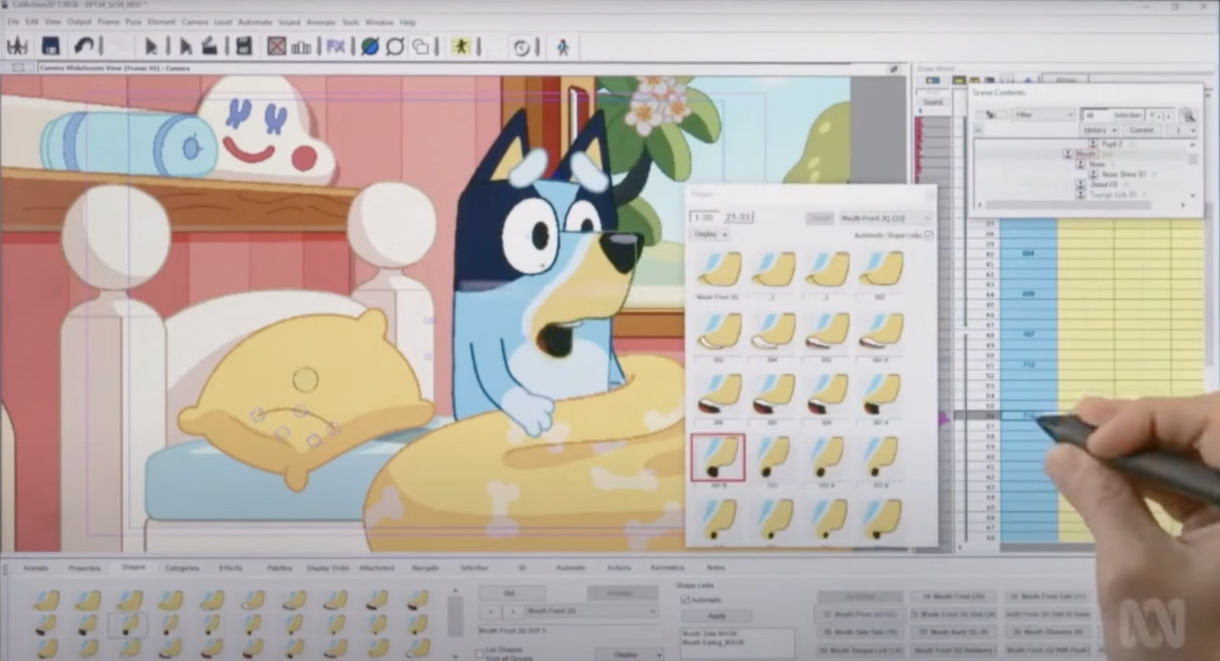Who doesn’t love the Aussie kids cartoon Bluey? Its art style, humour, and family values stand out to kids and adults alike. You may be wondering how they create and animate this heartwarming show?
The team behind Bluey uses CelAction2D for animation and Adobe After Effects for compositing. They use the illustration software Adobe Photoshop and Adobe Illustrator to create the artwork required for each episode.
Curious to know more about Bluey’s animation process and the software behind it? Read on as we cover more of the details.
About CelAction2D
Bluey uses CelAction2D for animating its characters, and it’s not alone with other popular shows like Peppa Pig using the same software.
CelAction2D is a specialised program for developing cut-out 2D animation, making it a leading choice among digital professionals in the rigging and puppet animation space.
Vectors or bitmaps, character models can now be manipulated more quickly and efficiently with the aid of a skeleton. Animation production is accelerated due to this rigging technology which allows for easy reuse of actions and characters.The skeleton framework’s movements are effortlessly interpolated and adapted according to the desired motion.
CelAction2D is a powerful animation program, but lacks the capability of creating vector backgrounds and characters in the app. To fulfill this purpose, users must take advantage of other software like Photoshop or Illustrator for all the artwork and designs.

In Bluey Season 3, Episode 29, there is a sequence where Bluey is having a dream and we get a behind the scenes look at CelAction2D being used to animate her.
About After Effects
Once the characters are animated and the scenes are drawn, all those elements can be brought into a program like After Effects to arrange the final product.
Adobe After Effects is a compositing tool that can be used to create motion graphics and animated visual effects. The software allows you to easily add in layers of motion, text, and visuals to bring elements together. With After Effects, you can customize your work with the help of different tools like keyframes and masks. You also have access to a wide range of effects that can be applied and adjusted to create a unique look.
Adobe After Effects is available as a stand-alone subscription or can be used by subscribers to the full Adobe Creative Cloud suite.
Who makes the TV show Bluey?
Ludo Studios is the talented production company behind the animated series Bluey. They are based in Brisbane, Australia – the location which Bluey the show is set. As a father of two girls, Joe Brumm, the original creator behind Bluey based much of the show on his personal parenting experiences. Bluey is distributed globally by BBC Studios and is featured on the Australian Broadcast Corporation (ABC Kids) and Disney Plus.

Making an episode of Bluey
Crafting a single episode of Bluey requires the hard work and dedication of an entire animating team – they take around four weeks to animate each episode! To give you an idea of just how much goes into every episode, here is a brief summary of the production process.
1. Script
For Bluey, the stories and characters are the all important foundation. The process begins with the production of scripts.
2. Storyboard
Pre-production drawings, known as storyboards, are created by artists that depict what will be featured in each episode.
3. Animatic
Editors take the storyboard and create an animatic. The animatic contains basic drawing showing the animation flow, timing, order etc.
4. Character Voices
From the animatic, some sound effects and music are added, along with the character voices.
5. Animation
All the content created gets given to the artists and animators. The artists and designers produce the final drawings of the characters, props and backgrounds. The animators take those drawings and create skeleton rigs to controls the characters and animate them as digital puppets. This is done using the CelAction2D software.
6. Music and sound
The music and sound department adds sound effects, while the a composer uses his instruments to write the score to each episode. Every episode is unique!
7. Final edit and viewing
The entire studio gets together to watch the final edit before signing off on the episode.
8. Release
The finished episode is given to distributors to release to the public!
